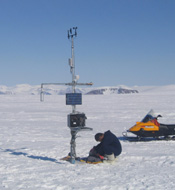

|
Variability of Arctic climate and sea ice over the past millennium: implications for ice cap mass balance |
Project summaryProxy sea ice & biological activity
|
The oxygen isotope composition of snowfall in the Arctic is determined by a complex range of factors (Giovinetto et. al., 1997), but can provide a proxy for local air temperature on the basis that lower temperatures will cause a greater degree of cooling and thus a greater degree of depletion of water containing heavier isotopes, as these water molecules condense and are precipitated preferentially. δ18O values can be translated into temperature estimates using transfer functions derived from regional data or site-specific studies of meteorological conditions and concurrent snow isotope measurements (Fisher, 1990; Grootes et. al., 1993).
δ18O and δ2H fractionate differently during evaporation, resulting in a characteristic ratio between the two measures. Variation in the deuterium excess, given as: For this field site we can compare the oxygen and hydrogen isotopes with meteorological data collected at Arctic stations on Ellesmere Island, and with data collected in recent years from the PoW icefield. The availability of local meteorological data will enable us to generate a more reliable temperature transfer function from the isotopic signal recorded in the ice core. |
 Automatic weather station on Prince of Wales icefield, used for constraining isotopic signatures with local meteorological measurements.
Automatic weather station on Prince of Wales icefield, used for constraining isotopic signatures with local meteorological measurements.
|